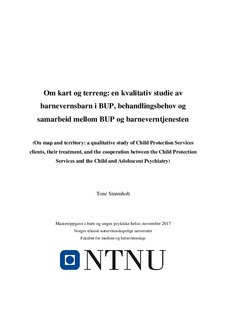Om kart og terreng: en kvalitativ studie av barnevernsbarn i BUP, behandlingsbehov og samarbeid mellom BUP og barneverntjenesten
Master thesis
Permanent lenke
http://hdl.handle.net/11250/2573617Utgivelsesdato
2017Metadata
Vis full innførselSammendrag
The high prevalence of mental health problems and disorders among child protection services (CPS) clients is well documented in the literature. Children placed out-of-home are the most disposed, but children living at home receiving support from the CPS also have a higher burden of disease. Consequently, the cooperation between the (CPS) and the Child and adolescent psychiatry (CAP) has been of great interest to ministries as well as researchers, since overcoming the obstacles preventing cooperation that is experienced by the two services requires understanding their cause.
The purpose of this qualitative study is to deepen our knowledge of how employees of the CWS and the CAP understand the development of mental health problems among CWS clients, what need of assessment and treatment these clients have, and how the employees have experienced the cooperation between the two services.
This was investigated in semi-structured interviews on the topic with three employees from the municipal CPS and three employees from CAP outpatient clinics. The interviews show a great degree of variation in treatment and use of different methods between different CAP outpatient clinics and insufficient adjustment of treatment according to the special needs of CPS clients. CPS and CAP employees cooperate to a certain extent on a case-by-case basis, but guidelines and routines do not exist. On an interorganizational level there are, to the knowledge of the employees, no formal agreements or cooperation. This suggests a considerable gap between reality and the guidelines and recommendations given by central authorities.
